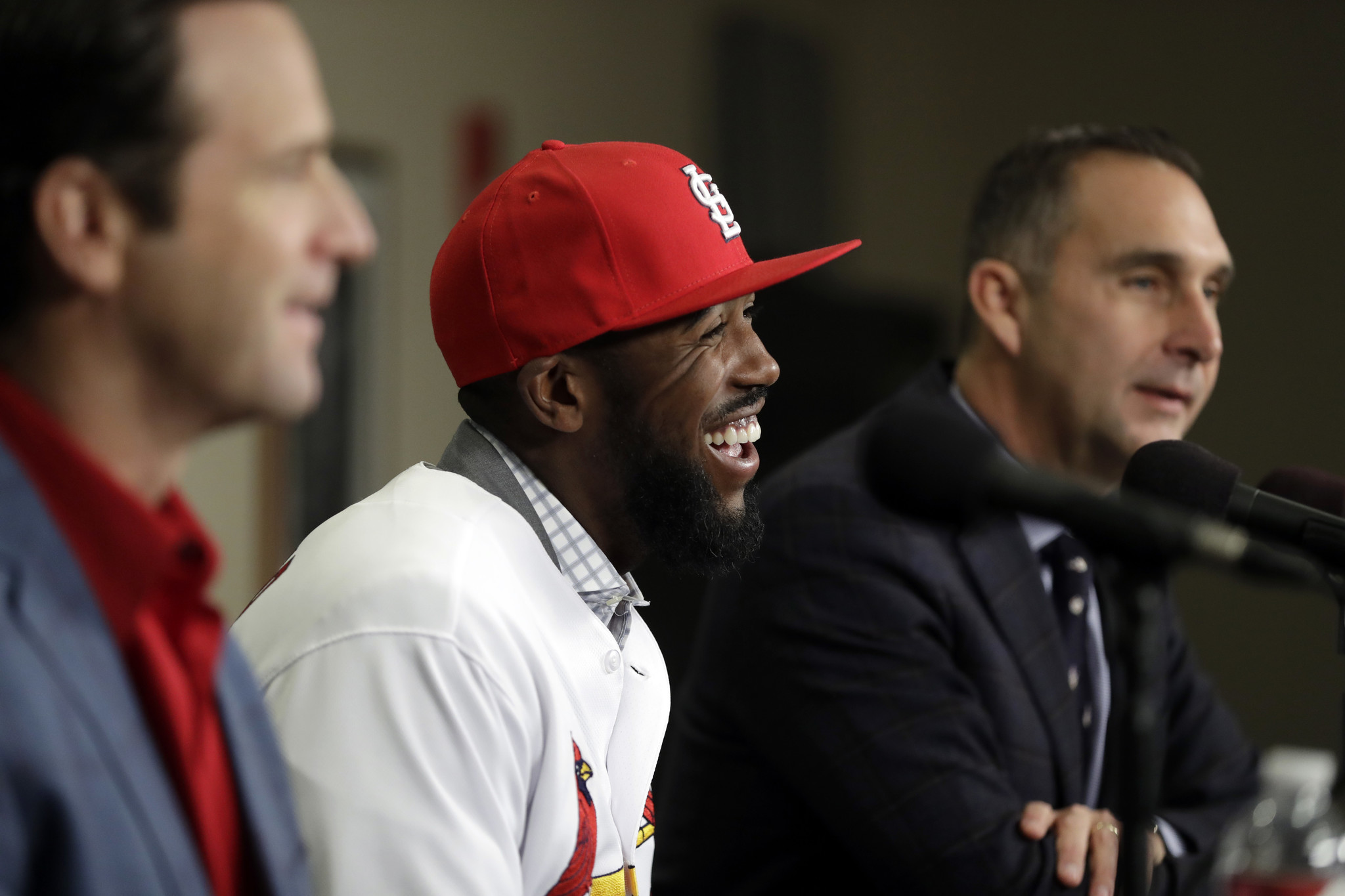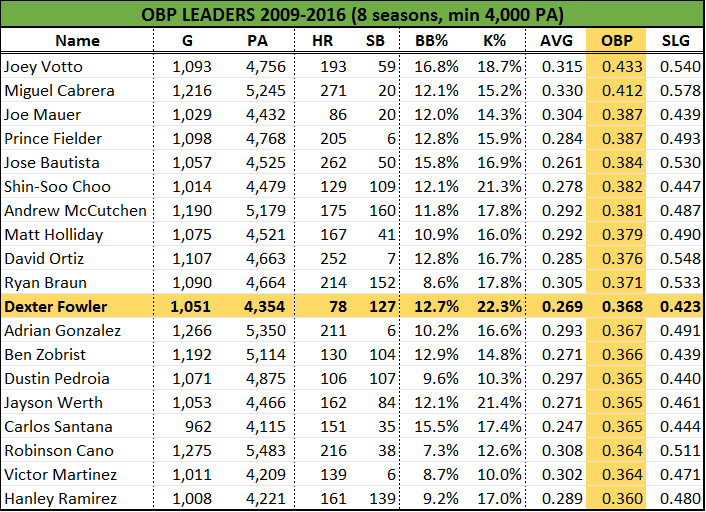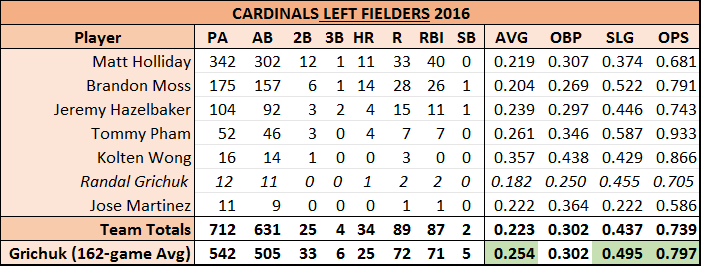The True Value of Dexter Fowler to the St. Louis Cardinals

On Friday afternoon, the St. Louis Cardinals finalized a 5-year, $82.5 million with former Cubs center-fielder Dexter Fowler. As has been explained in the media, the Fowler addition was meant to add more athleticism both on defense and atop the Cardinals’ lineup. At face value, this seems to make sense; Fowler’s skills are indicative of a lead-off hitting center fielder. In theory, inserting Fowler in center in place of incumbent Randal Grichuk should improve the outfield defense. In researching this theory; however, I have found that the ‘Fowler Effect’, while certainly providing plus-value, is not as straightforward as it may seem.
I will start with what we know. Offensively, Fowler is a bona-fide leadoff hitter as far as present day terms are concerned. While fans can get bogged down in batting averages (Fowler put up just a .276 mark in 2016), he did finish the year with a .393 OBP and was a table-setter for the first Chicago Cubs World Series victory in over 100 years. In fact, since he became a full-time MLBer in 2009, Fowler has ranked very highly when it comes to getting on base. Take a look at the following chart and see just how well he stacks up.
That list is every major leaguer who has accumulated a .360 OBP or better in at least 4,000 plate appearances throughout the last 8 years (500 PA per season). This chart speaks to two facts: the first being that Fowler has been nearly elite when it comes to getting on base, and the second being that Fowler has been fairly durable, averaging about 131 games played per season. He should be exactly what the Cardinals are looking for in terms of a leadoff hitter.
Now, if you desire look at two more charts. The first compares Fowler’s 162-game career averages to the total offensive production that St. Louis received out of their center fielders in 2016. The second does the same thing, but compares Randall Grichuk to Cardinals’ 2016 left fielders.
Focusing solely on rate statistics, we can conclude that the Cardinals are likely to get greater production in both center field and left field as a result of the Fowler addition. Fowler’s on-base skills compared to St. Louis center fielders in 2016 greatly outweighs the marginal decline in power potential at the position. Overall, a 55-point increase in OPS in center is very possible given that Fowler will still be playing in his prime at the age of 31. In addition, the added value on the base paths with Fowler in the lineup should further bolster the Cardinals’ offense.
Likewise, with Grichuk shifting over to left field, offensive output should increase at that position as well. Grichuk’s average rates in his young career are all noticeably greater than the total production supplied by Matt Holliday, Brandon Moss and company in 2016. As a player still developing, Grichuk could provide a greater increase in left field production than Fowler provides in center. Overall, Fowler’s signing should be a major boon to the Cardinals’ lineup.
Things are not as straightforward defensively. Despite the perception that Fowler should bring better defense to the Cardinal outfield, metrics show that the real defensive benefit may not be in center field, despite improvements made by Fowler as a result of playing deeper in 2016. No, instead the improvement will come in left field, the new home of aforementioned Randal Grichuk.
In 2016, Grichuk posted a Defesive Runs Saved figure of +7 and a UZR/150 of -1.8 while playing center field (949.1 innings). In comparison, Fowler posted a +1 DRS and +1 UZR/150 in 1027.1 innings playing center for the Cubs. For clarification’s sake, DRS and UZR are statistically very similar, but DRS is based on current year data, whereas UZR is an accumulated average of multiple seasons. You can read more about defensive metrics in this Sports on Earth article, but since we are comparing 2016 numbers, DRS is likely the more accurate metric. Therefore, Fowler (+1) may actually be a downgrade from Grichuk (+7) in center field. Of course, with such a small sample size, the number could easily swing in the other direction the following season.
The major point that I would like to get across though, once again, is that the Cardinals should benefit in left field thanks to the Dexter Fowler signing. In 2016, a combination of Matt Holliday (-8 DRS, 644 innings), Brandon Moss (+2 DRS, 355 innings), and Jeremy Hazelbaker (-2 DRS, 241.1 innings) accounted for about 85% of the Cardinals’ left field playing time. Adding the final DRS numbers of those three players results in a -8 left field DRS. Grichuk, on the other hand, has accumulated a +6 DRS in 404.1 innings in left field in his career. Again, this is a small sample size, but the total difference between what the Holliday/Moss/Hazelbaker trio and Randal Grichuk is 14 DRS. Given how well he held his own in center field last year, a full season of Grichuk in left field could dramatically improve the Cardinals’ left field defense. Even if Fowler is a slight downgrade in center, which seems unlikely, the difference should be easily made up for in left.
All along the Cardinals have maintained that their desire to add Dexter Fowler to the outfield mix stemmed from the need for more athleticism in all aspects of the game. Offensively, the benefit of adding Fowler is clear; he is an OBP pro. On defense, the benefits may not be as clear, but there will be benefits. Fans would be wise to pay just as much attention to Randal Grichuk in left as they do Fowler in center.
-Alex Vacca



















